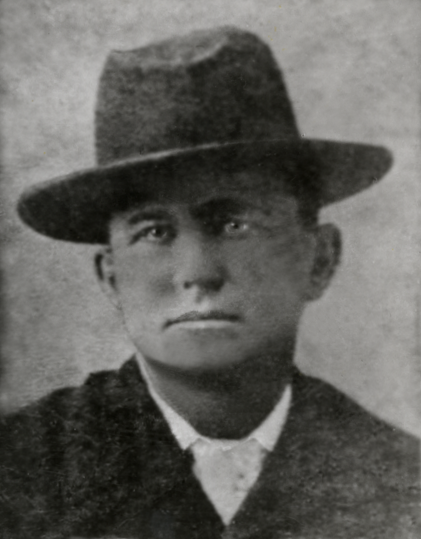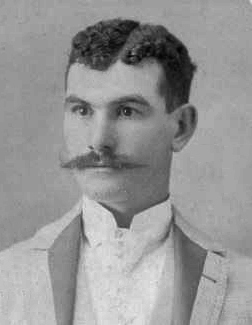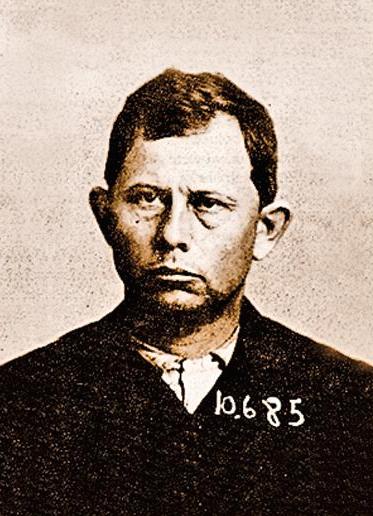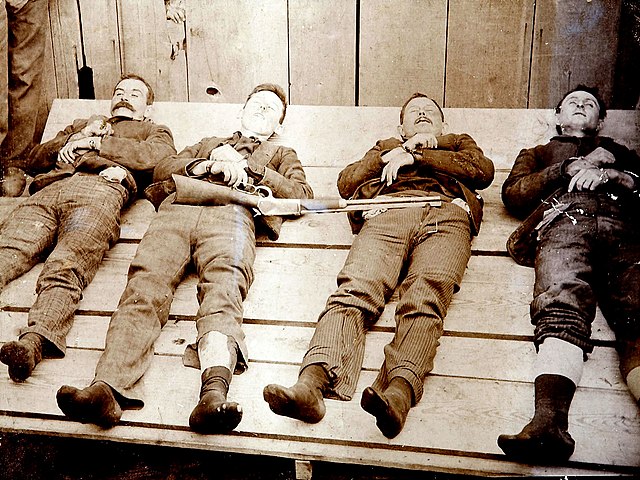Once upon a time, during the closing days of the Wild West, there was a group of mean and dangerous brothers called the Daltons. And together with their friends, they formed a gang that liked to rob banks and trains, steal horses, and any other illicit activity that might make them some money. Anyone who tried to interfere with their felonious enterprises had a good chance of getting pumped full of lead and ditched by the side of the road.
But then, October 5, 1892, gang leader Bob Dalton decided that five of them would enter the city of Coffeyville, Kansas, and rob two banks at once in broad daylight to show the whole world that the Dalton Gang was the most feared group of outlaws in the Wild West. But things didn’t really go his way and a massive shootout ensued between the Dalton Gang and the people of Coffeyville. When the smoke settled, eight people were dead, including four of the five gang members: Bob Dalton was dead, as was his brother Grat, Bill Powers, and Dick Broadwell. Youngest brother Emmett Dalton was the only survivor, despite sustaining dozens of wounds. Even so, he was arrested and sentenced to life in prison. Just like that, the Dalton Gang was no more.
Except that a fourth brother named Bill Dalton was still around. On that fateful day, he and another outlaw named Bill Doolin may have been waiting outside the city with fresh horses to help the gang make their escape. Once they found out what had happened to the others, they resolved to form a new group, led by the two of them. Oftentimes, they say that the sequel is never as good as the original, but that was not the case here, as the Doolin-Dalton Gang became more successful, more notorious, and longer-lived than the first incarnation. Eventually, it even gained a new name to match its fearsome reputation – it became known as the Wild Bunch.
Bill Dalton
Mason Dalton was born circa 1865 in Cass County, Missouri, to Lewis Dalton and Adeline Younger. The family relocated to Kansas where Mason and his 14 siblings grew up. Later in life, he started going by William “Bill” Dalton, so we are going to call him that from the beginning to make it less confusing. There are already enough Daltons going around without using two names for each one.
His mother was related to the Younger brothers, who were part of the notorious James-Younger gang alongside Frank and Jesse James. The gang predated the Wild Bunch by a couple of decades, so Bill Dalton and his brothers grew up hearing of their uncles’ daring and violent exploits. Even so, for a while, it seemed like the Dalton boys were destined to walk on the right side of the law. The family’s pride & joy was Frank Dalton. In 1884, he became a Deputy US Marshal for the Oklahoma Territory and was considered by his peers to be a brave and respected lawman. However, he was gunned down in 1887, while attempting to arrest a horse thief.
At first, the other Dalton brothers thought they could pick up the mantle left behind by big brother Frank. Grat Dalton took over his job as deputy marshal and then hired Bob and Emmett to serve as guards. But it became pretty obvious soon enough that they weren’t meant to walk the straight & narrow. It started with too much drinking and gambling on the job. Then there were a few incidents where the brothers got a bit too trigger-happy. And it ended with plain ol’ corruption, as the boys sought to supplement their meager salaries by abusing their authority. Sometimes they would “fine” a person instead of arresting them. Other times they would confiscate illegal goods but, every time, the cash & the cargo seemed to “mysteriously” vanish before reaching the sheriff’s station. Ultimately, the brothers just said “screw it” and started their gang.

As far as Bill Dalton was concerned, he, too, tried to live an honest life at first. He started out working various odd jobs with his brothers, before moving to Livingston, California, where he was employed by a rancher named Cyrus Bliven. Soon after, Bill fell in love with the rancher’s daughter, Jennie Bliven. The two got married in 1885 and had two children together – Charles and Grace. It really seemed like Bill Dalton had his life together – he started a family, he bought his own ranch, he opened a business, and even got involved in local politics. The people who knew him described him as charming, good-looking, and the “life of the party.” So what exactly possessed him to turn to a life of crime?
It seems that his brothers had a negative influence on Bill. Bob, Grat, and Emmett sometimes showed up at Bill’s ranch for a visit when they were looking to lay low from the authorities. It is possible that the brothers committed several robberies in the late 1880s – early 1890s and used Bill’s ranch as a hideout, but it is uncertain if Bill ever joined them in any of their ventures. He finally showed up on the sheriff’s radar in 1891, when somebody committed a train robbery in the town of Alila, California, which involved the murder of a locomotive fireman named George Radcliffe. Bob and Emmett Dalton were wanted for the crime. They managed to flee California, but Bill and Grat Dalton were arrested for helping them escape. Even though all charges against Bill were eventually dropped, his reputation was tarnished forever and he was considered “just another no-good Dalton boy.” At that point, there was no use in pretending anymore, so Bill accepted his new role in life as an outlaw, although we’re not really sure to what extent he participated in the illicit activities of the Dalton Gang. Who knows? After the Coffeyville massacre, with his brothers dead or in jail, Bill may have been tempted to return to ranching, if not for another man.
Bill Doolin
We arrive at the second namesake of the Doolin-Dalton Gang – William Doolin, born circa 1858 on a homestead northeast of Clarksville, Arkansas. His parents were Michael Doolin and Artemina Beller, a pair of law-abiding sharecroppers. Bill worked on the family farm until 1881, at which point the 23-year-old left the homestead to find his own way in life. Like Bill Dalton, he didn’t seem to be particularly inclined towards a life of crime, which makes it all the more curious that they ended up leading one of the most notorious gangs of the Wild West.
In the Oklahoma Territory, Doolin found work as a cowboy on the ranch of a Texan named Oscar Halsell, who liked Bill enough to take him under his wing and teach him to read and write. This was Doolin’s life for the next ten years, drifting from one ranch to another, filling whatever position was needed. We know that, during this time, he met some of the men who would later form part of his gang, but we are not sure what exactly prompted Bill to turn to robbery. By 1891, however, he was a member of the Dalton Gang and became an outlaw following a shootout in Coffeyville, Kansas.

Strangely enough, this isn’t the aforementioned bloody gunfight that got two Dalton brothers killed and ended the gang. This happened a year earlier when Doolin and a few cohorts wanted to celebrate the 4th of July with a keg of beer. But Kansas was a dry state at the time and the local lawmen didn’t take kindly to drunkards around there. Except that Doolin and his friends didn’t take kindly to local lawmen trying to confiscate their hooch, so both sides kindly started shooting at each other, resulting in two injuries and a life on the run for Bill Doolin.
Doolin had a somewhat contentious relationship with the Dalton brothers, particularly Bob Dalton who often acted as the leader of the group. Some sources claim that Doolin briefly left the gang alongside two other members named Charley Pierce and George “Bitter Creek” Newcomb, who are worth mentioning as they would later be part of the Wild Bunch. All three of them were angry with the Daltons because they felt Bob wasn’t quite equitable when it came to divvying up the loot. It seems this was one of those situations where everyone was equal, but some were “more equal than the others,” and some of the core members of the Dalton Gang received bigger shares than the rest.
Ultimately, this worked out in Doolin’s favor. After all, if he were one of Bob Dalton’s trusty sidekicks, then he probably would have been present in Coffeyville on the day of the gunfight and ended up in a cheap pine box right next to Bob and the others. But as things stood after October 5, 1892, Bill Doolin was now an independent gunman, ready to strike out on his own.
The Wild Bunch Rides
After the bloody shootout at Coffeyville, Doolin, Newcomb, and Pierce felt obligated to visit the Dalton household and pay their respects to the family matriarch who had just buried two sons and saw another imprisoned for life. While there, they met up with Bill Dalton and Doolin floated the idea of the four of them starting a new gang and picking up right where things left off. Bill accepted and the Doolin-Dalton Gang was born. Truth be told, Bill Doolin was the de facto leader of the group. Bill Dalton didn’t really have the credentials to lead a gang, but they probably added him in honor of his brothers, and for brand recognition, since the Dalton name was already known and feared throughout the West.
Of course, four men might make a nice barbershop quartet, but they are not enough for a dangerous gang, so the first thing to do was to draft a few more names to their roster. We’re not going to go through all of them. Just know that 11 men were part of the Wild Bunch, at one point or another. They all had colorful names such as William “Tulsa Jack” Blake and Dan “Dynamite Dick” Clifton, and they all ultimately met their ends in violent shootouts, so expect a lot of gunfights in the near future.

In fact, let’s start right now. We believe that the first crime committed by the new & improved gang was the robbery of the Ford County Bank in Spearville, Kansas, on November 1, 1892. Following their escape, the authorities identified one of the gunmen as Oliver “Ol” Yantis and put the marshals on his trail. They tracked down Yantis at his sister’s ranch on November 29 and gunned him down when the outlaw refused to surrender. Yantis died of his wounds the next day, becoming the first member of the Wild Bunch to go out in a hail of bullets, just a month after the gang was formed.
The rest of the outlaws were more successful and spent the first half of 1893 robbing multiple trains and banks without too much hassle. But on September 1, they took part in one event remembered in Western lore as one of its fiercest gunfights, and solidified their reputation as the Wild Bunch.
It became known as the Battle of Ingalls, named after the town of Ingalls, Oklahoma, which the criminals sometimes used as a hideout. As we mentioned, by that point, the gang had plenty of successful robberies under its belt, so it was firmly on the radar of the U.S. Marshals who vowed to risk life and limb in order to bring the Wild Bunch to justice. On September 1, 1893, a posse of over a dozen marshals led by John Nixon tracked the outlaws to Ingalls. Most of the gang members had been there for weeks, drinking, gambling, and, most importantly, spending money, which is why the locals looked the other way when it came to how they obtained their ill-gotten gains. As the marshals rode into town, all of the criminals were playing cards in the saloon, except for Roy Daugherty aka “Arkansas Tom” Jones who was sick in bed in his room of the O.K. Hotel. As George Newcomb exited the saloon, the marshals opened fire, prompting all of the outlaws to abandon their poker game and respond in kind. Within seconds, the tiny town of Ingalls transformed into a warzone, covered in smoke, with bullets flying in every direction.
Hearing the commotion outside, “Arkansas Tom” Jones went to the window of his hotel room and opened fire on the lawmen, mortally wounding Deputy Marshal Tom Houston. The surprise attack allowed some of the other outlaws to make their way to the stable and retrieve their horses. They charged out of the livery with guns blazing and killed two more marshals – Lafeyette Shadley and Dick Speed, as well as an innocent bystander who got caught in the crossfire. With the lawmen on the defensive, the Wild Bunch was able to ride out of town, with only a few minor injuries to show for their troubles.
There was still the little matter of “Arkansas Tom” Jones, who was trapped inside his hotel room. Given that they had just lost three of their own, the marshals were in no mood to negotiate, so they gave Jones two options: surrender or they would throw dynamite in his room. Jones surrendered, was arrested, and later convicted to 50 years in prison, although he was released after serving less than 20. Strangely enough, getting caught prolonged his life substantially, as he outlived all of his compatriots by two-to-three decades. However, during the 1920s, Jones started robbing banks again, and in 1924 he was finally killed in a gunfight in Joplin, Missouri, as the last of the Wild Bunch.
One by One, They All Fall Down
After making an escape from Ingalls, the rest of the gang decided to lay low for the rest of the year, but by 1894 they were back to their old shenanigans, and by shenanigans, we, of course, mean robbery, violence, and the occasional murder. A stagecoach in Arkansas, a train in Oklahoma, a bank in Kansas – little by little, the Wild Bunch were becoming the biggest terror in the West, but it was their little stunt in Ingalls that made them Public Enemies #1 in the eyes of the marshals. Undoubtedly, there were more than a few lawmen who would have loved to catch the gang members in their crosshairs. The officers doggedly pursued the Wild Bunch from state to state, led by a famed trio of marshals named Bill Tilghman, Heck Thomas, and Chris Madsen, who were collectively known as the Three Guardsmen. Who knows? Maybe one day we’ll cover them on Biographics, as well.
Anyway, having the law constantly on their trail didn’t seem to deter the Wild Bunch as the gang committed one brazen act after another, including a daring raid on Southwest City, Missouri, which saw the Wild Bunch successfully ride out of town following a bank robbery, despite the fact that marshals and townspeople fired at them from both sides of the street as the gang was making its getaway. It was another successful score that left the gang unscathed and almost $4,000 dollars richer. It really seemed like the Wild Bunch had more than a few rabbit’s feet tucked somewhere in their saddles, the way they kept avoiding any serious injuries, but their luck was about to run out and it started with none other than Bill Dalton.

On June 8, 1894, Dalton was laying low at his home in Ardmore, Oklahoma, when a posse of armed lawmen surrounded the house. If Bill would have exited his home, hands high in the air, he might have survived, but that’s not how things played out. Instead, he jumped out the window, gun in hand, and started running towards the posse. It was one final act of defiance from a man who decided to go out on his own terms and, as you might imagine, he was immediately ripped to shreds by the hail of gunfire. The final Dalton had been dealt with, marking an end to one of the most feared names to come out of the Old West. His wife, who stuck by his side and raised the kids while he was out with the rest of the Wild Bunch, identified his body and had it shipped to California to be buried.
For the rest of the gang, even with Dalton’s death, it was business as usual since it was unlikely that any of them expected to make it to old age, anyway. Even so, the rest of the year was pretty quiet, with no other notable events occurring in 1894. 1895, however, was a completely different story, as all the other Wild Bunch members started getting picked off one by one.
First off, we had “Tulsa Jack” Blake. On April 3, 1895, five members of the gang had just robbed another train near Rock Island, Oklahoma, and made camp for the night in a basin along the Cimarron River. Unbeknownst to them, a posse of U.S. Marshals sniffed out their trail and approached their camp in the dead of night. The lawmen called for the outlaws to surrender but, of course, this was never going to happen. Another wild shootout quickly erupted and, roughly 200 shots later, as the gunsmoke cleared, Blake lay dead, while the rest of the bandits managed to make their escape.
Just a month later, the Wild Bunch lost two of its founding members, George “Bitter Creek” Newcomb and Charley Pierce. On May 2, the two of them traveled to the Dunn Ranch in Payne County, Oklahoma. Newcomb wanted to visit his lover, a woman named Rose Dunn, pretty famous in her own right, but better known as Rose of Cimarron. The gang was also on friendly terms with her brothers, whom they knew from Ingalls, so Newcomb and Pierce felt pretty safe as they approached the ranch. What they didn’t know was that the Dunn brothers preferred money over friendships and that they intended to collect on the large bounties placed on all members of the Wild Bunch. To them, Newcomb and Pierce showing up at their home was like a turkey basting and stuffing itself and then jumping in the oven of its own volition. The temptation was just too great so, as the two unsuspecting outlaws got off their horses, they were ambushed and gunned down and the Dunn brothers became several thousand dollars richer.
Four months later, another member of the gang named “Little Bill” Raidler was shot and injured by one of the Three Guardsmen and taken in alive. He was sent to jail for ten years but was released in 1903 due to health reasons and he died a year later. Therefore, Raidler became the only member of the Wild Bunch not to be killed directly in a gunfight, even though his death came as a result of the injuries he sustained in his shootout with the marshals.
By 1896, half of the gang was gone and the others had split up, hoping to evade the authorities as long as possible. George “Red Buck” Weightman was killed in another gunfight with the marshals on March 4, 1896, while “Dynamite Dick” Clifton and “Little Dick” West were gunned down in 1897 and 1898, respectively.
We are left with just one man – Bill Doolin, the leader of the Wild Bunch. In June 1896, Guardsman Bill Tilghman captured him without incident at Eureka Springs, Arkansas, and sent him to the federal prison in Guthrie, Oklahoma, to await trial. As it happened, Clifton was also imprisoned there, so the two of them and a dozen other inmates executed a prison break on July 5. Doolin ran away to his father-in-law’s farm in Lawson, Oklahoma, to be with his wife and son. Perhaps he realized that it was the end of the road for him, so he wanted one more chance to see his family. Unsurprisingly, marshals soon tracked him down to the homestead and, on August 25, 1896, they trapped Doolin in an ambush. Like Dalton, he could have surrendered, but he preferred to go out shooting, so Doolin raised his gun and aimed it at the marshals, but didn’t get a chance to pull the trigger before one of the deputies emptied a double-barrel shotgun straight into his chest.
And then there were none…Eleven violent deaths for eleven violent men meant the end of the most ruthless gang that the Old West had ever seen; the gang known as the Wild Bunch.



